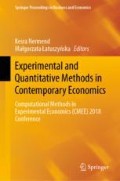Abstract
Mass land appraisal is a specific type of appraisal. A suitable algorithm used for mass appraisal constitutes one of the main determinants of the quality of achieved results. Many of the algorithms cluster real estate in accordance with specific criteria, such as a real estate type, its characteristics or location. Assuming a “real estate location” as a clustering basis, we use terms such as a taxation zone (which originates from a basic application of mass appraisal, which involves ad valorem real estate taxation), along with an elementary terrain (which originates from the nomenclature used in spatial planning). The main goal of this chapter is to find the solution to the designation of such zones, or real estate clusters for the purpose of mass land appraisal conducted with the use of Szczecin Algorithm of Real estate Mass Appraisal (SAREMA). Each mass appraisal algorithm has its own specificity, and consequently, it may pose various requirements to designated zones or real estate clusters (here referred to as location attractiveness zones—LAZ’s). The chapter presents the methods of LAZ’s designation formed on the basis of the existing cadastral districts, real estate market analysis, and hierarchical clustering. The chapter is additionally focused on the manner of determining LAZ optimal number and consequently the number of properties that will be included in an automated mass appraisal process in a given zone. The uniformity of isolated LAZ’s was subject to verification with the use of an entropy ratio, especially constructed for that purpose. The study was conducted on the land plots located in the city of Szczecin.
Access this chapter
Tax calculation will be finalised at checkout
Purchases are for personal use only
References
Arguelles, M., Benavides, C., Fernandez, I.: A new approach to the identification of regional clusters: hierarchical clustering on principal components. Appl. Econ. 46(21), 2511–2519 (2014). https://doi.org/10.1080/00036846.2014.904491
Boongoen, T., Iam-On, N.: Cluster ensembles: a survey of approaches with recent extensions and applications. Comput. Sci. Rev. 28, 1–25 (2018). https://doi.org/10.1016/j.cosrev.2018.01.003
Bradbury, K.L., Mayer, C.J., Case, K.E.: Property tax limits, local fiscal behavior, and property values: evidence from Massachusetts under Proposition 2,5. J. Public Econ. 80, 287–311 (2001)
Davidson, I., Ravi, S.S.: Agglomerative hierarchical clustering with constraints: theoretical and empirical results. In: Jorge, A.M., Torgo, L., Brazdil, P., Camacho, R., Gama, J. (eds.) Knowledge Discovery in Databases: PKDD 2005. Lecture Notes in Computer Science vol. 3721, pp. 59–70. Springer, Berlin, Heidelberg (2005). https://doi.org/10.1007/11564126_1
Dedkova, O., Polyakova, I.: Development of mass valuation in Republic of Belarus. Geomatics Environ. Eng. 12(3), 29–39 (2018). https://doi.org/10.7494/geom.2018.12.3.29
Doszyń, M.: Ekonometryczna wycena nieruchomości. Studia i Prace Wydziału Nauk Ekonomicznych i Zarządzania 26, 41–52 (2012)
Fang, Y.X., Wang, Y.H.: Selection of the number of clusters via the bootstrap method. Comput. Stat. Data Anal. 56, 468–477 (2012). https://doi.org/10.1016/j.csda.2011.09.003
Guo, G.: Regionalization with dynamically constrained agglomerative clustering and partitioning (REDCAP). Int. J. Geogr. Inf. Sci. 22(7), 801–823 (2008). https://doi.org/10.1080/13658810701674970
Hozer, J.: Regresja wieloraka a wycena nieruchomości. Rzeczoznawca Majątkowy 2, 13–14 (2001)
Hozer, J., Kokot, S., Foryś, I., Zwolankowska, M., Kuźmiński, W.: Ekonometryczny algorytm masowej wyceny nieruchomości gruntowych. Uniwersytet Szczeciński, Stowarzyszenie Pomoc i Rozwój, Szczecin (1999)
Hozer, J., Kokot, S., Kuźmiński, W.: Metody analizy statystycznej rynku w wycenie nieruchomości. PFSRM, Warszawa (2002)
Jahanshiri, E., Buyong, T., Shariff, A.R.M.: A review of property mass valuation models. Pertanika J. Sci. Technol. 19, 23–30 (2011)
Kantardzic, M.: Data Mining. Concepts, Models, Methods, and Algorithms. Wiley-IEEE Press (2003)
Kokot, S.: Model wielu regresji pojedynczych w wycenie nieruchomości. Studia i Materiały Towarzystwa Naukowego Nieruchomości 12(1), 106–122 (2004)
Kolesnikov, A., Trichina, E., Kauranne, T.: Estimating the number of clusters in a numerical data set via quantization error modeling. Pattern Recogn. 48(3), 941–952 (2015). https://doi.org/10.1016/j.patcog.2014.09.017
Korteweg, A., Sorensen, M.: Estimating loan-to-value distributions. Real Estate Econ. 44(1), 41–86 (2016). https://doi.org/10.1111/1540-6229.12086
Kotkowski, P.: Propozycja nowej klasyfikacji terenów miejskich. Acta Universitatis Lodziensis, Folia Geographica Socio-Oeconomica 2, 115–124 (1999)
Lis, C.: Sieci neuronowe a masowa wycena nieruchomości, vol. 318, pp. 331–338. Zeszyty Naukowe Uniwersytetu Szczecińskiego, Prace Katedry Ekonometrii i Statystyki, “Mikroekonometria w Teorii i Praktyce” (2001)
Müller, A.C., Guido, S.: Introduction to Machine Learning with Python. O’Reilly, Sebastopol (2016)
Park, B., Bae, J.K.: Using machine learning algorithms for housing price prediction: the case of Fairfax County, Virginia housing data. Expert Syst. Appl. 42, 2928–2934 (2015)
Prystupa, M.: O potrzebie dalszych prac nad zastosowaniem regresji wielorakiej w wycenie nieruchomości. Rzeczoznawca Majątkowy 4, 16–17 (2000)
Raschka, S., Mirjalili, V.: Python Machine Learning. Packt Publishing, Birmingham, Mumbai (2017)
Sawiłow, E.: Analiza wybranych metod modelowania wartości katastralnych nieruchomości. Acta Scientiarum Polonorum Geodesia et Descriptio Terrarum 8(2), 27–38 (2009)
Suchecka, J. (ed.): Statystyka przestrzenna. C.H. Beck, Warsaw (2014)
Surowiec, G., Malczewska, A.: Automatyzacja procesu wyodrębniania stref izowartościowych nieruchomości w oparciu o zdjęcia lotnicze. Archiwum Fotogrametrii, Kartografii i Teledetekcji 11, 21–35 (2001)
Tzioumis, K.: Appraisers and valuation bias: an empirical analysis. Real Estate Econ. 45(3), 679–712 (2017)
Unpingco, J.: Python for Probability, Statistics, and Machine Learning. Springer International Publishing (2016)
Wiśniewski, R.: Zastosowanie sztucznych sieci neuronowych do wyceny masowej. Wycena 1, 15–20 (1998)
Wu, X., Ma, T., Cao, J., Tian, Y., Alabdulkarim, A.: A comparative study of clustering ensemble algorithms. Comput. Electr. Eng. 68, 603–615 (2018). https://doi.org/10.1016/j.compeleceng.2018.05.005
Zurada, J., Levitan, A.S., Guan, J.: A comparison of regression and artificial intelligence methods in a mass appraisal context. J. Real Estate Res. 33(3), 349–387 (2011)
Author information
Authors and Affiliations
Corresponding author
Editor information
Editors and Affiliations
Rights and permissions
Copyright information
© 2020 Springer Nature Switzerland AG
About this paper
Cite this paper
Kokot, S., Gnat, S. (2020). Optimization of Location Attractiveness Zones for the Purpose of Property Mass Appraisal. In: Nermend, K., Łatuszyńska, M. (eds) Experimental and Quantitative Methods in Contemporary Economics. CMEE 2018. Springer Proceedings in Business and Economics. Springer, Cham. https://doi.org/10.1007/978-3-030-30251-1_20
Download citation
DOI: https://doi.org/10.1007/978-3-030-30251-1_20
Published:
Publisher Name: Springer, Cham
Print ISBN: 978-3-030-30250-4
Online ISBN: 978-3-030-30251-1
eBook Packages: Economics and FinanceEconomics and Finance (R0)

